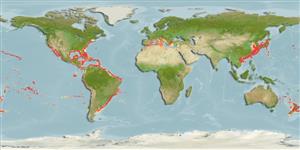Common names from other countries
Classification / Names / Names
Common names | Synonyms | Catalog of Fishes (gen., sp.) | ITIS | CoL | WoRMS
Environment: milieu / climate zone / depth range / distribution range
Ecology
Pelagic; depth range 0 - 785 m (Ref. 116106). Tropical
Eastern Pacific, Western Central Atlantic and the Mediterranean.
Length at first maturity / Size / Weight / Age
Maturity: Lm ? range ? - ? cm Max length : 15.0 cm TL male/unsexed; (Ref. 833)
Found in slope (Ref. 116106). Feeds on euphausiids and small copepods (Ref. 116551).
Life cycle and mating behavior
Maturity | Reproduction | Spawning | Eggs | Fecundity | Larvae
Members of the phylum Ctenophora are hermaphroditic. Life cycle: Eggs develop into planktonic juveniles called cydippid and later gradually adopt the form of adults.
Haddock, S.H.D. and J.F. Case. 1999. (Ref. 1606)
IUCN Red List Status (Ref. 130435)
CITES status (Ref. 108899)
Not Evaluated
Not Evaluated
Human uses
| FishSource |
Tools
More information
Age/Size
Growth
Length-weight
Length-length
Morphology
Larvae
Abundance
Internet sources
Estimates based on models
Vulnerability
Low vulnerability (10 of 100).
Price category
Unknown.
